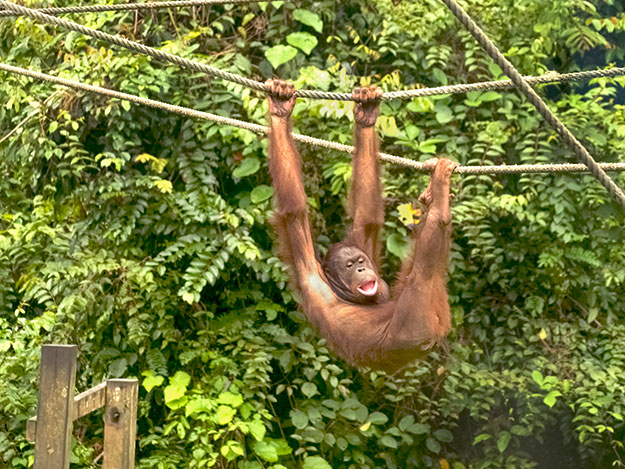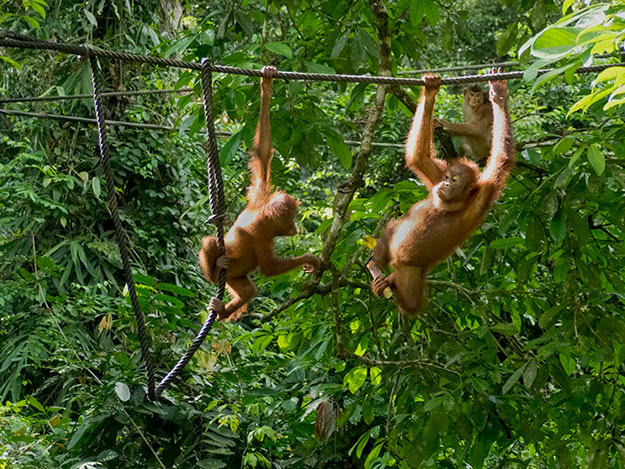“Say hello to the orange ones,” my friend said when he dropped me at the airport. He was referring to orangutans, known for their distinctive orange color and endangered status. For years I had dreamed of seeing them in their natural habitat and now, with a little luck, my dream would finally come true. I boarded the plane to Sabah, a Malaysian State on the island of Borneo, arguably the best place in the world to see orangutans in the wild.

People have been fascinated for centuries by orangutans because of their humanistic traits. They are the second largest ape, after gorillas. Close cousins to Homo sapiens, they share 96.4% of their DNA with humans. Even their name speaks to our closeness; the word orangutan translates to “man of the forest.” Yet this fascination has not assured their continued existence. According to “The Last Stand of the Orangutan, State of Emergency: Illegal Logging, Fire and Palm Oil in Indonesia’s National Parks,” a report published in 2007 by the United Nations Environment Program (UNEP), palm oil plantations are currently the leading cause of rain forest destruction in Malaysia and Indonesia. The report estimates that 98% of the rain forest may be destroyed by 2022, with lowland forest succumbing much sooner.
The smaller scale slash and burn agricultural technique employed by local farmers creates additional environmental stress. Soil beneath the jungle canopy is of notoriously poor quality. At best, farmland created by this means produces crops for a few short years. Once the scant minerals have been depleted, the land is abandoned. The jungle that was lost to slash and burn methods never recovers and as their habitat shrinks, orangutan numbers dwindle. Today, an estimated 11,000 remain in the rain forests of Borneo, where once there were an estimated 230,000, according to the World Wildlife Fund.

Aware of the potential for orangutans to disappear entirely, in 1964 the Malaysian Government, in partnership with the Sabah Wildlife Department, founded the Sepilok Orangutan Rehabilitation Center. Not long afterward, the non-profit Orangutan Aware UK became a valued partner. Over the years, their combined efforts have rescued, rehabilitated, and returned hundreds of orangutans to the wild. The team leaps into action whenever they receive a report of a young orangutan that has been orphaned, is injured or sick, or is being held captive.
The rescued baby is brought back to the rehabilitation center and placed in quarantine. Once the new arrival gets a clean bill of health, it is released into the nursery. Then the hard work begins. Rescued orangutans in Borneo are often only a few months old, so they have not had the benefit of learning how to survive from their mothers. The babies must learn how to forage, what plants are safe to eat, how to climb and swing in the treetops, how to make their nests each night, which animals pose a threat, etc. To accomplish this, the staff has developed a buddy system. They pair each new arrival with another young orangutan who is slightly older and more experienced.
This process can take up to three years. When the the immature orangutans are deemed ready, they are released into the greater nature reserve. This area is completely open to the rain forests of Sabah. There are no fences and the animals come and go as they please, however staff continues to monitor them and conducts a feeding from a high wooden platform twice a day. Some of the rehabilitated orangutans come to the viewing platform to eat for the rest of their lives, while others gradually stop coming and melt into the general forest population.

In order to double my odds of seeing orangutans, I chose to stay at Sepilok Nature Resort. This property backs up to the Sepilok Orangutan Rehabilitation Center, which lies within the 4,294 hectare Kabili Sepilok Forest Reserve. According to reports from previous guests, with no fences to keep them out, orangutans often wander into the grounds of the resort during the breakfast hours. Alas, though I was eagerly seated on the outdoor restaurant deck at dawn on my first day, the orangutans of Borneo did not cooperate. Not a one made an appearance, so at 9 a.m. I walked next door to the Rehabilitation Center.
I arrived at the viewing platform a few minutes before the 10 a.m. feeding. It was already quite crowded with tourists, but I managed to grab a spot that provided a relatively good view of the platform. A staff member climbed up with a large rattan basket full of fruit and began tossing bananas onto the wooden platform. A dozen or so macaque monkeys hovering in the treetops scampered down and began bickering over the booty. For quite a while it looked like only macaques would show up.

Suddenly, a staff member on the ground shouted, “She is coming!” A ripple of excitement ran through the crowd. All eyes swiveled to the jungle floor. The vegetation rustled, leaves parted, and a huge orange orangutan climbed up onto the platform. She was the star of the show from the moment she arrived. The staff member shoved macaques away with his hands, arms, and even booted them out of the way with his legs to make way for her. When he began tossing bananas onto the jungle floor to entice the macaques to leave the platform, the orangutan saw her opportunity. Her long, gangly arm whipped out with lightning speed. She plucked a banana right out of the feeder’s hand. The crowed laughed, rooting for the orangutan.
It’s hard to imagine that this big orange ape could be intimidated by the smaller macaques, but their sheer numbers overwhelm. Often, the orangutans will retreat in the face of such odds. Fortunately, today was not one of those days. She swung from the wires above the platform, hoarding an armload of bananas. Every so often she returned to grab more fruit, using the man with the wicker basket as a shield from macaque attacks. Like thousands of others who had come before me, I was hooked.

My appetite whetted, I returned for the 3 p.m. feeding, arriving well ahead of time in order to secure a spot front and center. The orangutans must have decided that strength lay in numbers. Five of them showed up for the afternoon feeding, cleared the platform, and gorged on the fruit. That evening, back at Sepilok Nature Resort, I wandered down to the open-air restaurant for dinner. I’d barely settled into my chair when I saw movement out of the corner of my eye. A huge orangutan had stealthily strolled down the wooden deck and stopped directly behind a woman sitting across from me. Its long arm flashed out and reached around her. With lightning speed it scooped up the mound of rice on the woman’s dinner plate and fled. The woman didn’t even have time to scream. Now that’s what I call an up-close and personal experience, and one I couldn’t have even imagined when I set out to see orangutans in the wild!
Borneo was hot and steamy and I was exhausted and drenched in sweat at the end of each day. But it was worth whatever discomfort I had to tolerate to see so many of the “orange ones” in the wild. I only hope they will be there for the next generation to see as well.
Author’s comments:
Sepilok Orangutan Rehabilitation Center opens at 9 a.m. and closes at 4 p.m. The price of admission is 30 MYR ($7.37 USD at the time of writing), with an additional 10 MYR ($2.46 USD) for cameras. Feedings are conducted at 10 a.m. and 3 p.m. Plan to arrive early for best viewing spots. No bags are allowed inside the reserve because orangutans will try to steal them. Bags must be placed in storage lockers that are provided free of charge by the center. Retain your ticket rather than leaving it in the locker, as staff must punch it at the entrance to the viewing platform. The center lacks signage, so if you arrive at a glassed-in rather than an open air area, you have landed at the nursery rather than the feeding platform.

very funny image !! Awesome article Barbara.
Thanks so much Priya. Glad you enjoyed it.
We likewise visited Sepilok and saw a few types of Monkey/gorilla family, including a mother and infant orangutan pair up a tree next to the stream.
Love this article, Barbara! Your writing style makes the reader feel inclusive, like they are with you on your travels!
High praise Crystal – but you always say very kind things about my writing. Thank you SO much.
Hi Barbara. We also visited Sepilok. So human like how the mothers selected bits of food for their babies to try.
Wow! This is such a great article. It feels like I am with you there during the visit. Keep up the good work.
Thank you so much Kathy. That’s high praise for a writer.
Awesome article Barbara! Up close and personal for sure. Afraid that I agree with your comment about man and enduring peace. Yes, incredibly sad. For someone who has \”retired\” you still manage to get around!
LOL – retired is a subjective term. I don’t go to an office any more but I sure travel and work a LOT of hours. Difference is, this is a job I love!
I really enjoyed my visit here too! The jungle and rainforest have been some of the high points of my travels thus far! This week I put out a blog post on one of our early morning animal viewing boat rides — I linked it here. 🙂
Hi Linda: Glad you had a positive experience as well. Borneo is one of those places that everyone said was dangerous – but of course it’s not.
Wow Barbara, what a nice experience. This endangered species are so amazing. Their skills and intelligence are beyond compare.
One of my favorite articles Barb. You definitely bring each place you visit alive and you make me feel that I’mmliving it with you. Take care my Friend!
Very descriptive article, Barbara. I can almost say I was there with you and I didn’t have to endure the heat. Totally agree that unless humanity can learn to respect our natural habitat then how can we learn to live with each other without wars?
Truer words were never spoken, Betty.
What beautiful creatures Barbara. Humans need to get their act together and live in harmony with sentient beings.
Totally agree with that sentiment Ryan, but even apes can be warlike. Jane Goodall had to confront this at one point in her research, when a new troop of chimpanzees intruded on the territory of those she was studying and an all-out, bloody war ensued. I’m not sure I believe anymore that man is capable of creating enduring peace. Sad.